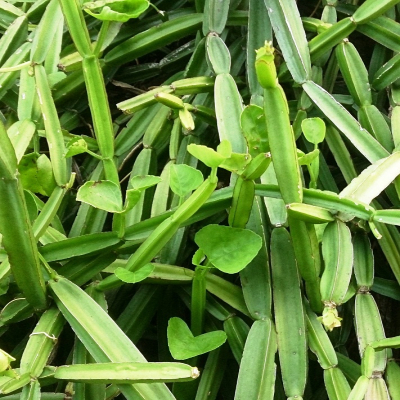Cissus quadrangularis Linn.
Synonyms : Vitis quadrangularis(Linn.) Wall.ex Wight
Family : Vitaceae
Group : Anti-arthritic/anti-rheumatic/anti-inflammatory
Parts Used : Whole plant
Vernacular Names :-
| English | : | Adamant creeper |
| Malayalam | : | Changalamparanta |
| Hindi | : | Hadjora |
| Sanskrit | : | Asthisrnkhala |
| Bengali | : | Harjora |
| Kannada | : | Manjora-valli |
| Tamil | : | Perandai |
| Telungu | : | Vajravalli, Harjora, Harsankar, Kandavel, Nallar |
Distribution and Habitat: Found throughout hotter parts of India.
Botany: A tendril climber with stout fleshy jointed quadrangular stems, tendrils simple, long, slender,
- Leaf: Opposed, in addition to the normal roots, some aerial roots arising from the jointed nodes grow downwards and strike the soil. Leaves simple, broadly reniform, entire or toothed, rounded, truncate or cuneate at the base.
- Flowers: Small, greenish, in shortly peduncled cymes, petals 4, hooded at the apex.
- Fruits: Ovoid or globose, red berries, seeds ellipsoid.
Properties: It is light, sweet, hot, alterative, anthelmintic, stomachic, aphrodisiac, carminative
Chemical constituents: Plant contains proteins 12.8%; fat and wax 1.0%; fibre 15.6%; carbohydrates 36.6%; mucilages and pectins 1.2% on dry basis. A yellow wax, tartaric acid and the acid potassium salt are present. The plant is remarkably rich in vitamin C. Calcium oxalate crystals account for the irritating action of fresh stems.
Uses: It is used in fracture, swellings, scurvy, colonopathy, asthma, burns and wounds, colic, skin diseases, chronic ulcers, ophthalmopathy.
Formulations: Asthisamhara taila, Laksha guggulu, Asthisamharadi churna, Darvi kavtha, and Dasyadi kvatha.
Propagation: Cuttings.


